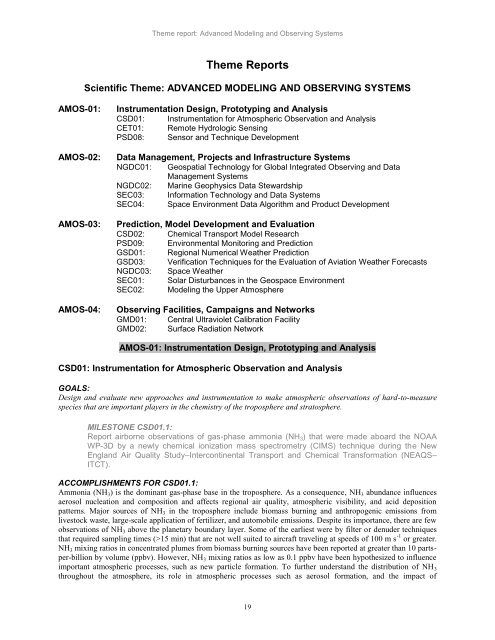Scientific Theme: Advanced Modeling and Observing Systems
Scientific Theme: Advanced Modeling and Observing Systems
Scientific Theme: Advanced Modeling and Observing Systems
Create successful ePaper yourself
Turn your PDF publications into a flip-book with our unique Google optimized e-Paper software.
<strong>Theme</strong> report: <strong>Advanced</strong> <strong>Modeling</strong> <strong>and</strong> <strong>Observing</strong> <strong>Systems</strong><br />
<strong>Theme</strong> Reports<br />
<strong>Scientific</strong> <strong>Theme</strong>: ADVANCED MODELING AND OBSERVING SYSTEMS<br />
AMOS-01: Instrumentation Design, Prototyping <strong>and</strong> Analysis<br />
CSD01: Instrumentation for Atmospheric Observation <strong>and</strong> Analysis<br />
CET01: Remote Hydrologic Sensing<br />
PSD08: Sensor <strong>and</strong> Technique Development<br />
AMOS-02: Data Management, Projects <strong>and</strong> Infrastructure <strong>Systems</strong><br />
NGDC01: Geospatial Technology for Global Integrated <strong>Observing</strong> <strong>and</strong> Data<br />
Management <strong>Systems</strong><br />
NGDC02: Marine Geophysics Data Stewardship<br />
SEC03: Information Technology <strong>and</strong> Data <strong>Systems</strong><br />
SEC04: Space Environment Data Algorithm <strong>and</strong> Product Development<br />
AMOS-03: Prediction, Model Development <strong>and</strong> Evaluation<br />
CSD02: Chemical Transport Model Research<br />
PSD09: Environmental Monitoring <strong>and</strong> Prediction<br />
GSD01: Regional Numerical Weather Prediction<br />
GSD03: Verification Techniques for the Evaluation of Aviation Weather Forecasts<br />
NGDC03: Space Weather<br />
SEC01: Solar Disturbances in the Geospace Environment<br />
SEC02: <strong>Modeling</strong> the Upper Atmosphere<br />
AMOS-04: <strong>Observing</strong> Facilities, Campaigns <strong>and</strong> Networks<br />
GMD01: Central Ultraviolet Calibration Facility<br />
GMD02: Surface Radiation Network<br />
AMOS-01: Instrumentation Design, Prototyping <strong>and</strong> Analysis<br />
CSD01: Instrumentation for Atmospheric Observation <strong>and</strong> Analysis<br />
GOALS:<br />
Design <strong>and</strong> evaluate new approaches <strong>and</strong> instrumentation to make atmospheric observations of hard-to-measure<br />
species that are important players in the chemistry of the troposphere <strong>and</strong> stratosphere.<br />
MILESTONE CSD01.1:<br />
Report airborne observations of gas-phase ammonia (NH3) that were made aboard the NOAA<br />
WP-3D by a newly chemical ionization mass spectrometry (CIMS) technique during the New<br />
Engl<strong>and</strong> Air Quality Study–Intercontinental Transport <strong>and</strong> Chemical Transformation (NEAQS–<br />
ITCT).<br />
ACCOMPLISHMENTS FOR CSD01.1:<br />
Ammonia (NH3) is the dominant gas-phase base in the troposphere. As a consequence, NH3 abundance influences<br />
aerosol nucleation <strong>and</strong> composition <strong>and</strong> affects regional air quality, atmospheric visibility, <strong>and</strong> acid deposition<br />
patterns. Major sources of NH3 in the troposphere include biomass burning <strong>and</strong> anthropogenic emissions from<br />
livestock waste, large-scale application of fertilizer, <strong>and</strong> automobile emissions. Despite its importance, there are few<br />
observations of NH3 above the planetary boundary layer. Some of the earliest were by filter or denuder techniques<br />
that required sampling times (>15 min) that are not well suited to aircraft traveling at speeds of 100 m s -1 or greater.<br />
NH3 mixing ratios in concentrated plumes from biomass burning sources have been reported at greater than 10 partsper-billion<br />
by volume (ppbv). However, NH3 mixing ratios as low as 0.1 ppbv have been hypothesized to influence<br />
important atmospheric processes, such as new particle formation. To further underst<strong>and</strong> the distribution of NH3<br />
throughout the atmosphere, its role in atmospheric processes such as aerosol formation, <strong>and</strong> the impact of<br />
19
















